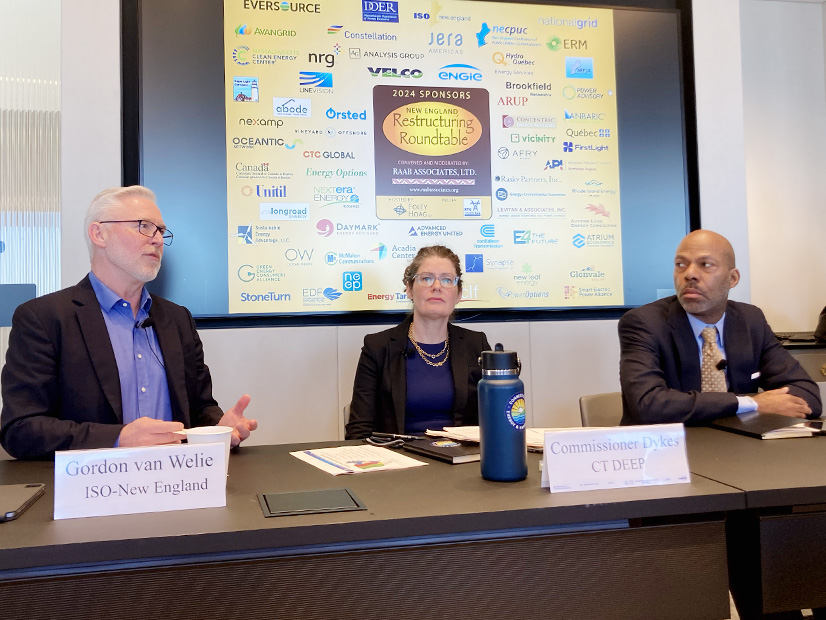
As intermittent renewables proliferate in New England, the region must do a better job incentivizing reliable, dispatchable resources that can support the grid as it decarbonizes, speakers at a Raab Associates roundtable said.
As intermittent renewables proliferate in New England, the region must do a better job incentivizing reliable, dispatchable resources that can support the grid as it decarbonizes, speakers at Raab Associates’ New England Electricity Restructuring Roundtable emphasized March 22.
“We cannot remove conventional generation before we stand up its replacement,” said Charles Dickerson, CEO of the Northeast Power Coordinating Council, adding the region will face shortfalls if it fails to heed this warning.
“The more renewables we have, the more I get prickly around adequacy,” Dickerson added. “It’s not how much is there; it’s how much is there when you need it.”
Gordon van Welie, CEO of ISO-NE, said the RTO’s ongoing efforts to reform its capacity market should help New England more efficiently ensure resource adequacy, but added that more changes likely are needed to align the region’s wholesale electricity markets with the clean energy transition. (See ISO-NE Moving Forward with Prompt, Seasonal Capacity Market Design.)
“I can’t miss the opportunity to make a pitch about carbon prices,” said van Welie, who has long expressed support for the concept but has indicated ISO-NE would need support from all New England states to proceed. (See ISO-NE: States Must Lead on Carbon Pricing.)
Van Welie said the RTO anticipates increasing renewable energy will reduce revenues from the energy market, requiring more money to come from the capacity market and state-led power purchasing agreements. A carbon price could help prevent an over-reliance on the capacity market and PPAs, van Welie said.
“You’d tax the carbon emissions at source, put that into the offer price, but then you would rebate the money that you’re collecting from those carbon emissions directly back to load at the wholesale level, so you’d mitigate the price impact,” van Welie added. He called the mechanism “an elegant way of trying to balance the consumer impact with the incentives needed to drive the thing you want, which is to reduce carbon emissions.”
Dickerson noted that inverter-based resources also bring new challenges related to ride-through capabilities and cybersecurity threats, and that standardization is needed to ensure resources meet the technical requirements needed for grid reliability.
“We’ve had no less than five or six episodes across the country where an inverter-based resource may have tripped offline because of what we can call a normal blip,” Dickerson said. “Not only did that particular inverter-based resource come offline, it took all the inverter-based resources offline that were connected to it. That’s unsustainable.”
While Dickerson stressed that the risks associated with inverter-based resources have already arrived, van Welie said the Eastern Interconnection likely is “fine for the next five years,” with problems likely emerging “around 10 years out.”
Batteries can use synthetic inertia to help mitigate the loss of spinning thermal resources, “but the inverters need to be designed to do it,” van Welie said, adding this will likely require some type of regulation.
Commissioner Katie Dykes of the Connecticut Department of Energy and Environmental Protection acknowledged the need to ensure grid reliability as the resource mix changes but said the region must continue to accelerate the deployment of clean energy.
“We really have to scale up all our efforts in regards to clean energy if we’re going to achieve our goals,” Dykes said.
Dykes said carbon pricing is “an important tool,” but added it’s “just one tool, and we need a number of different tools in order to see the new entry coming in that can maintain reliability at a rate that ratepayers can afford.”
Dykes added that future procurements could extend to developing generation technologies like advanced nuclear, geothermal and hydrogen fuel cells. She said she’s heard from developers that investing in advanced nuclear projects makes little sense in restructured markets compared to vertically integrated markets.
“We can’t afford to take those types of things off the table,” Dykes said. “We have to figure out how to accommodate them.”
The commissioner highlighted the efforts of Connecticut, Massachusetts and Rhode Island to coordinate offshore wind procurements — bids are due for all three states March 27, with the winning bids to be selected in August. (See New England States Delay Offshore Wind Solicitations.)
Dykes called the coordinated procurement “a template for multistate coordination,” while advocating “predictable, regular auctions” going forward.
“We’re in a moment of extraordinary collaboration,” Dykes said. “That’s what gives me encouragement.”
Liz Anderson, chief of the Energy and Ratepayer Advocacy Division at the Massachusetts Attorney General’s Office, stressed the need to keep ratepayer interests front and center. Anderson said the region should consider the cumulative impacts of programs and investments on electricity costs when designing programs, noting that skyrocketing costs will hinder the clean energy transition.
“A lot of conversations are happening in silos,” Anderson said. “We need to start thinking more holistically about all these costs together.”

